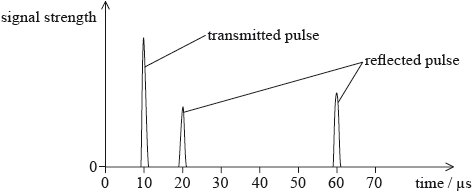| Date | May 2014 | Marks available | 1 | Reference code | 14M.3.HL.TZ2.20 |
| Level | Higher level | Paper | Paper 3 | Time zone | Time zone 2 |
| Command term | Determine | Question number | 20 | Adapted from | N/A |
Question
This question is about ultrasound.
An ultrasound pulse is transmitted into the body of a patient. The pulse is partially reflected at a fat–muscle boundary and then, deeper in the body, at a muscle–bone boundary. The graph shows the variation with time of the signal strength at the transducer.

Muscle has density \(1.08 \times {10^3}{\text{ kg}}\,{{\text{m}}^{ - 3}}\) and acoustic impedance \(1.70 \times {10^6}{\text{ kg}}\,{{\text{m}}^{ - 2}}{{\text{s}}^{ - 1}}\).
Define acoustic impedance
(i) Calculate the speed of ultrasound in muscle.
(ii) Determine the thickness of the muscle layer in the patient.
State one advantage and one disadvantage of using ultrasound of frequency 1 MHz, rather than 3 MHz, in medical diagnosis.
Advantage:
Disadvantage:
Markscheme
product of density of the substance and the speed of sound in that substance;
(i) \(c = \left( {\frac{{1.70 \times {{10}^6}}}{{1.08 \times {{10}^3}}} = } \right){\text{ }}1570{\text{ (m}}\,{{\text{s}}^{ - 1}}{\text{)}}\);
(ii) read-off to yield time of \(40 \times {10^{ - 6}}{\text{ (s)}}\);
travel time \( = 20 \times {10^{ - 6}}{\text{ (s)}}\);
thickness \( = \left( {1570 \times \frac{{40 \times {{10}^{ - 6}}}}{2} = } \right){\text{ }}3.1{\text{ (cm)}}\)\(\,\,\,\)or\(\,\,\,\)3.2 (cm);
Award [3] for a bald correct answer.
Award [2 max] for answer of 6.2 (cm) or 6.3 (cm).
advantage: greater penetration / less attenuation / can scan organs at greater depth;
disadvantage: less resolution / image has less detail / image less sharp;
Examiners report
(a) was an easy mark, but many were not specific about the values relating to a particular medium.
(b)(i) was another easy mark but the calculation of muscle thickness in (ii) was error prone. Many candidates forgot to halve the time difference between the reflected pulses. ECF marking was often required.
(c) was done reasonably well, but with quite a few getting the advantages and disadvantages confused.

